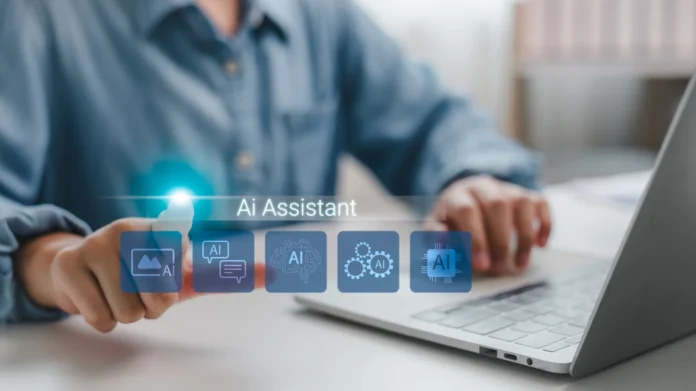AI substantially enhances everyday productivity tools by automating repetitive tasks and improving collaboration. Tools like chatbots and AI assistants streamline workflows, while content generators create customized marketing materials. AI integration allows for quicker decision-making through advanced data analysis. Additionally, it helps identify individual strengths within teams for task allocation. Organizations can achieve substantial efficiency gains, yet challenges in adoption remain. Exploring these developments further reveals the changing scenery of AI-driven productivity solutions.
Highlights
- AI-driven productivity tools automate repetitive tasks, enhancing efficiency and allowing users to focus on higher-value work.
- Digital assistants manage schedules and workflows, streamlining daily operations and improving time management.
- Generative AI tools create customized content, such as marketing materials and creative prompts, transforming content creation processes.
- AI applications facilitate real-time data analysis and predictive workflow management, supporting informed decision-making and proactive issue resolution.
- Collaborative AI tools improve teamwork by identifying the best individuals for specific tasks and enhancing overall communication across teams.
Understanding AI-Powered Productivity Tools
As organizations increasingly adopt digital transformation, understanding AI-powered productivity tools becomes paramount for enhancing operational efficiency. AI applications like chatbots and automated meeting transcription streamline repetitive tasks, allowing human agents to focus on strategic initiatives. By automating code completion and bulk content generation, these tools encourage human augmentation, enabling employees to achieve more in less time. Furthermore, the integration of AI in decision-making enhances data analysis, revealing trends and perspectives that inform organizational strategies. As AI-powered tools continue to refine productivity workflows, embracing these technologies promotes a sense of belonging among teams, uniting them in their collective efforts to innovate and succeed in an increasingly evolving online environment. AI improves collaboration among team members by identifying the best individuals for specific tasks, further enhancing overall productivity. Additionally, AI tools can streamline operations by minimizing human error, making workflows more efficient. Adaptation to these advancements is essential for thriving in today’s business world, and will also help to revolutionize and change the business scene, and also to obtain a deeper understanding.
Categories of AI Tools in Daily Use
The proliferation of AI tools in daily use has revolutionized various aspects of productivity, rendering previously time-consuming tasks more efficient. AI applications now encompass categories such as digital assistants, which help manage schedules and automate workflows through tools like ChatGPT and Google Gemini. In content creation, platforms like Jasper AI and Sudowrite generate customized marketing materials and creative prompts, respectively. Moreover, video and image generation tools such as Synthesia and DALL·E 3 allow for innovative visual storytelling. Search and research capabilities have also evolved with systems like Perplexity and NotebookLM, providing real-time, citation-rich results. These tools are integrated with various apps and platforms for automation, collectively enhancing productivity, nurturing creativity, and enabling users to achieve their goals seamlessly. Additionally, these advancements have led to significant improvements in overall efficiency, as many of these tools offer free trials to explore their features without commitment.
The Impact of AI on Task Efficiency
Although traditionally viewed as a supplementary tool, AI has emerged as a catalyst for enhancing task efficiency across various sectors. Task analysis reveals significant benefits, with customer service agents managing 13.8% more inquiries per hour and programmers completing 126% more projects weekly with AI assistance. Efficiency metrics indicate that less skilled workers experience a 14% productivity increase, while frequent AI users save an average of 5.4% of their work hours weekly. Particularly, professionals engaged in routine writing experience higher speed and quality outcomes. While AI optimizes performance in simpler tasks, AI assistance increases users’ performance by 66%, thus organizations must guarantee that employees understand where AI can be most effectively leveraged to prevent potential declines in productivity when faced with complex challenges. Moreover, AI systems can help quickly communicate tacit knowledge to less skilled workers, further enhancing their productivity. Generative AI can boost worker productivity by nearly 40% when used within its capabilities, underscoring the importance of proper training.
Challenges in AI Adoption for Productivity
Despite the promising benefits of AI integration in productivity, organizations encounter numerous challenges that hinder effective adoption. Implementation challenges include significant upfront costs for infrastructure, training, and workflow redesign, which can disrupt existing processes. Many organizations face adoption barriers, such as a shortage of skilled personnel, complex approval procedures, and resistance from employees wary of new technologies. Additionally, the generational divide in AI adoption creates varying rates of acceptance across the workforce. With 46% of executives highlighting skill gaps as a primary barrier, companies must overcome these obstacles to leverage AI’s full potential. As organizations invest aggressively in AI, balancing immediate costs with long-term ROI expectations remains critical for successful integration and utilization. The J-curve phenomenon illustrates how companies may initially experience productivity losses before realizing the longer-term benefits of AI adoption. However, it is noted that AI has the potential to generate 170 million new jobs worldwide by 2030, emphasizing the importance of overcoming these challenges. Furthermore, the long-term AI opportunity is estimated at $4.4 trillion in added productivity growth potential from corporate use cases, underscoring the value of successful AI adoption.
Key AI Tools Transforming Workflows
Revolutionary AI tools are reshaping workflows across various sectors, enhancing productivity and efficiency. Tools like ChatGPT and Google Gemini provide AI assistance in writing and content creation, allowing for seamless brainstorming and complex query handling. Jasper AI generates customized marketing content, while Buffer optimizes social media strategies. Organizations are experiencing workflow optimization, with reports of a 66% increase in task throughput and a predicted 40% surge in employee productivity through AI automation. Notably, a recent study found that using AI tools resulted in a 19% slowdown in completing tasks, which contrasts with the generally positive perception of AI’s impact. As 42% of companies are considering AI adoption in the near future, other solutions, such as AI chatbots and predictive analytics tools, facilitate real-time communication and data analysis, further enhancing team collaboration. Moreover, the study revealed that developers took 20% longer to complete tasks when aided by AI, which highlights the importance of caution in straightforward AI implementation. As 78% of companies accept AI, these tools indicate a significant shift toward more streamlined and effective operational practices in today’s work environments.
Future Trends in AI-Driven Productivity
The future terrain of AI-driven productivity is ready for revolutionary growth, marked by the integration of hyper-automation and advanced decision support systems. Emerging AI applications are set to redefine workflows, providing full automation from strategic decision-making to subtle resource allocation. Additionally, AI tools are essential for businesses of all sizes to optimize processes and reduce manual labor. Future enhancements promise predictive workflow management that proactively addresses bottlenecks while minimizing manual oversight in compliance checks and data validation. Real-time analytics and personalized recommendations will guide professionals in making informed decisions customized to their roles. Furthermore, as AI productivity tools increase efficiency, organizations will find themselves better positioned to thrive in a competitive landscape. Notably, tools like Gumloop’s automation capabilities can seamlessly connect LLM models to workflows, enhancing productivity across various teams. Additionally, as cross-functional collaboration flourishes through unified communication hubs, teams will benefit from smart task delegation and automated reporting. Consequently, the convergence of these innovations is expected to promote a more cohesive and efficient work environment, reinforcing a shared sense of purpose across organizations.
Balancing AI Benefits With Human Expertise
As organizations increasingly integrate artificial intelligence into their operations, balancing the benefits of AI with human proficiency becomes essential. This role evolution emphasizes leveraging AI’s strengths in automating repetitive tasks, allowing employees to focus on creativity and emotional intelligence. Evidence suggests that productivity can triple for specific tasks when AI assists, underscoring the potential for enhanced efficiency. Additionally, AI excels in rapid data processing which allows for quicker decision-making. However, human oversight remains critical, particularly in high-stakes decisions where ethical and situational factors are paramount. The fact that 40% productivity increase has been reported by employees using AI highlights the transformative impact AI can have on workplace efficiency.
Conclusion
To summarize, AI-powered productivity tools are revolutionizing the way individuals and organizations approach daily tasks, enhancing efficiency and streamlining workflows. While the benefits of these technologies are substantial, including improved task management and data analysis, challenges such as integration and user adaptation remain prevalent. As the terrain of AI continues to evolve, it is imperative to strike a balance between leveraging these innovations and maintaining human oversight, ensuring that proficiency and creativity are not overshadowed by automation.
References
- https://metr.org/blog/2025-07-10-early-2025-ai-experienced-os-dev-study/
- https://blog.webex.com/innovation-ai/the-ai-productivity-tools-shaping-2025/
- https://nativeteams.com/blog/best-ai-tools-for-productivity
- https://www.venasolutions.com/blog/ai-statistics
- https://www.apollotechnical.com/27-ai-productivity-statistics-you-want-to-know/
- https://numerous.ai/blog/ai-productivity-tools
- https://www.ibm.com/think/insights/ai-productivity
- https://moldstud.com/articles/p-the-benefits-of-using-ai-powered-tools-in-software-development
- https://www.coursera.org/articles/ai-productivity-tools
- https://www.synthesia.io/post/ai-tools


